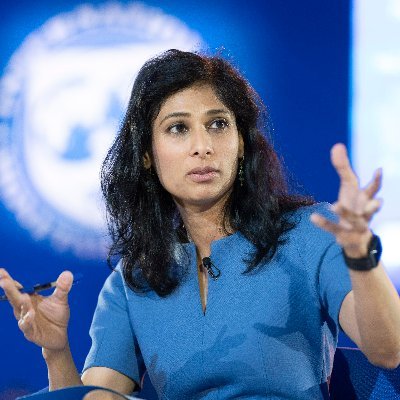-By LeN Economic Affairs Correspondent

(Lanka-e-News -17.June.2025, 11.10 PM) With a backdrop of soft-lit chandeliers and tightly-scripted optimism, the Shangri-La Hotel in Colombo played host to the International Monetary Fund’s (IMF) First Deputy Managing Director Gita Gopinath, who delivered a compelling address on “Sri Lanka’s Road to Recovery: Debt and Governance.”, it showed her inexperience and lack of knowelege about Sri Lankan Economy and its recovery.
The conference, attended by diplomats, technocrats and policy veterans, unfolded at what the IMF calls a “critical juncture” in Sri Lanka’s economic journey. But beyond the applause and academic rhetoric, deeper questions about sovereignty, sustainability, and fairness continue to haunt the island’s painful path to solvency.
Gopinath’s opening remarks echoed a now-familiar IMF refrain: Sri Lanka is a success story—on paper, at least. Inflation is tamed, GDP is recovering (growing 5% in 2024), and tax revenues have soared by two-thirds. Medicine and fuel queues are no longer daily ordeals, and the fiscal discipline badge has been earned through hard-nosed structural reform. In her words, “bold reforms and the commitment of the Sri Lankan people” have turned a corner.
But whose corner was truly turned?
Beneath the figures lies a starker reality. Sri Lanka’s recovery, as architected under the IMF’s Extended Fund Facility (EFF), has been built on the backs of ordinary citizens through what critics call a regime of “privatised pain.” The tax burden has risen significantly, indirect taxes disproportionately hurting the lower-income brackets. Electricity bills are now cost-reflective—in other words, unaffordable. Fuel subsidies have vanished. Public services groan under pressure.
True, the IMF doesn’t hide this. Gopinath acknowledged that these measures “tested the social fabric.” But the elephant in the room remains: is this recovery sustainable, or simply a managed balancing act that pushes pain forward for another generation?
Central to the IMF’s narrative is the “successful” sovereign debt restructuring—a euphemism for painful negotiations that, while impressive on diplomatic paper, have left many watching with unease. Gopinath was keen to boast: $3 billion forgiven, $25 billion restructured, repayment stretched over two decades, interest rates lowered. Bonds are back on global indices; Sri Lanka’s credit rating has improved.
But at what cost?
Under heavy IMF orchestration, China—Sri Lanka’s largest bilateral lender—was pressured into forgiving $7 billion. The move, controversial and geopolitically sensitive, is seen by Beijing insiders as a precedent it was loath to set. For Colombo, the IMF’s involvement—though nominally as a “good office”—was far from neutral. Critics argue that Sri Lanka, once a bastion of non-aligned diplomacy, is now beholden to Western financial orthodoxy.
The restructuring also involved domestic debt—a high-wire act. Avoiding nominal haircuts, the government opted for maturity extensions and rate reductions. But with the Central Bank and national pension funds heavily exposed, concerns loom over future liquidity, pension fund returns, and long-term macro-stability.
There’s no question Sri Lanka’s governance required urgent reform. The country’s spectacular economic collapse in 2022 was as much about corruption and cronyism as it was about COVID-19 or inflation.
To that end, the IMF takes credit for some achievements: strengthening the Central Bank’s independence, improving public financial management, and introducing anti-corruption legislation. Gopinath optimistically cited analysis predicting that these reforms could boost GDP by 7% over the next decade.
But observers question whether this governance is substantive or performative. The same political actors who led Sri Lanka into economic freefall remain influential, reshaped but not replaced. Whistleblower protections are limited. The legal framework exists on paper, but prosecutions remain rare. Transparency, as many civil society groups lament, is still a currency Colombo is hesitant to spend.
The IMF is acutely aware of Sri Lanka’s patchy reform history. “Of the 16 IMF programs Sri Lanka has engaged in over the years, about half ended prematurely,” Gopinath noted, adding ominously, “Hard-earned gains were reversed.”
She’s not wrong. The country has a legacy of using IMF programs as reputational cover for austerity, before veering off course once elections or populist demands intervene. The IMF, having failed to impose sustained discipline over past cycles, is now trying a new strategy: public engagement. The conference encouraged dialogue, inclusion, and civil society engagement—words not traditionally associated with multilateral financial diplomacy.
Still, the IMF’s dogma remains intact: reform, or regret. But many ask—reform for whom?
What the IMF speech didn’t say is often more telling than what it did.
The EFF loan amount—$2.9 billion—is a rounding error in the context of Sri Lanka’s economy and the magnitude of its debt crisis. The real influence lies not in the money but in the conditions attached. Sri Lanka, under the program, must seek IMF approval for basic fiscal policy decisions—including offering tax concessions to investors.
In essence, sovereignty has a co-signatory.
The program’s technocratic micromanagement has also stifled domestic policy imagination. There’s little room for bold industrial policy, developmental banking, or new social safety nets. Every proposal must pass through Washington’s sieve. For a country reeling from collapse, this is less “guidance” and more financial probation.
Gopinath ended with the hopeful refrain: “This time must be different.” She echoed Sri Lankan President Anura Kumara Dissanayake’s call that this should be the country’s last IMF program.
It’s a noble sentiment. But whether it reflects genuine empowerment or a carefully curated illusion remains to be seen.
The truth is, Sri Lanka’s recovery remains fragile, conditional, and externally brokered. Reform fatigue is real. Public anger simmers. Corruption still festers. And unless Sri Lanka moves from merely surviving to truly thriving—on its own terms—this “different” time may, yet again, turn out to be just another familiar chapter in a long cycle of dependency.
A hard-earned recovery. A heavily-managed narrative. A lingering question: Who really owns Sri Lanka’s future?
-By LeN Economic Affairs Correspondent
---------------------------
by (2025-06-17 19:54:22)
Leave a Reply